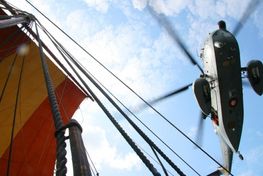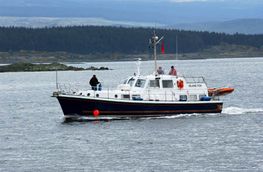Worldclass research

When the Sea Stallion Sunday the 1st of July puts to sea bound for Ireland three major questions will be part of its cargo:
• the reconstruction – Is the hypothesis about the original ship, made by the Viking Ship Museum true og will scholars and boat builder have to revise their thoughts on the Viking long ships?
• the reconstruction and the sailing ability of the ship type – how seaworthy is a ship like the Sea Stallion and how does it manoeuvre?
• the reconstruction and the function, organization and logistics of the crew – What is working and what’s not? And what can we conclude about the Viking Age?
A full scale test
”The Sea Stallion is a reconstruction an original were only 20 percent is preserved today. Therefore the Sea Stallion can be considered a hypothesis in the eyes of a scholar. The hypothesis reflects our interpretation of the original ship and its missing pieces. During the sail this hypothesis will be tried full scale. If we have added pieces that do not work they will brake or not work intentionally. If the ship in its entirety and individual pieces is functioning our interpretation is most likely to be correct. … and the Sea Stallion can therefore be considered a representative for the original ship and for the ship type in general,” says Tinna Damgård-Sørensen, director of the Viking Ship Museum.
”analyzing the validity of this hypothesis – and the answer to the first big question – will be based on estimations of data appearing during the test”.
The ships sailing ability
”The second question asked is about the sailing ability of the ship. We will try and get closer to an answer during the sail from Roskilde to Dublin, but also during a number of shorter and controlled test sails in the Irish Sea,” Tinna Damgård-Sørensen explains.
”This experimental journey gives us an opportunity to examine and document the seaworthiness, the manoeuvres and the speed under realistic conditions. Resting time and days of waiting will be included and written down. That will make it easier to estimate the entire time of travelling. The result will give us an idea of the travel speed of the Viking long ship and can be compared to results made by other ships sailing the same distance”.
”Controlled test sails illustrate the capacity of ship and crew under different conditions. The testing will be carried out repeatedly on the same route but under different conditions and are meant to test the efficiency of the Sea Stallion both as a sailing ship and a rowing vessel. Comparing the sailing ability and efficiency of the ship with other known ship types will put a perspective on the possibilities offered by the long ship in the Viking Age,” the museum director explains.
”The end result will bring insight into the strategic choices a naval leader faced when bringing a long ship like the Sea Stallion from A to B a thousand years”.
The same as back then
”Ship and crew are organized after the same principals described in Nordic literature from the 11th and 12th century. Skipper is in charge and just beneath him are two steersmen – one for each shift. The ship is divided into invisible rooms matching the different functions that need to be manned during sailing. Each room has a chairman – again one for each shift”.
”To be able to answer the third big question the functions of ship and crew needs to be carefully examined during sailing – that means steering, handling during turns, raising and putting down the mast, rowing and handling og oars, commutation down through the ship, cooking and so on. Furthermore we are examining life on board – the health of the crew, food, water consumption and sleep. And finally the logistic problems of preparing and seeing through a journey this long in a Viking long ship crewed by sixty five,” says Tinna Damgård-Sørensen.
The ships function, organization and logistics will be analysed based on the ship log book and sailing manual, the diaries of the foremen, the nurse and cook as well as film and photo documentation.
FATCS
And then……? The journey to Dublin and the test sail – with years of preparation – is a milestone in maritime archaeology. It’s without a doubt one of the biggest experiments ever carried out. Therefore an organized and well structured control of the research is needed. The Viking Ship Museum has appointed a research commission for the experimental journey.
Participants are:
• Museum director, historian Tinna Damgård-Sørensen – chairman of the commission
• Senior Scholar and hired for the project, archaeologist Jan Bill – preparation of publications and structure.
• Head of the museum boatyard, boat builder Søren Nielsen – reconstruction.
• Head of museum activities, Steersman Poul Nygaard – test sailing
• Museum inspector, archaeologist Anton Englert – the experimental journey
Several crew members appointed by the commission will be responsible for the documentation of individual problems during the journey.
• Log book and skippers report: Skipper Carsten Hvid in co-operation with museum inspector Anton Englert
• Report of test sailing results: Steersman Poul Nygaard
• Boat builders report: Boat builders Søren Nielsen and Tom Nicolaisen
• Trimming report: Steersman Kjetil Silnes
• Report from the different rooms in the ship: A co-operation between the foremen in each room, boat builder Søren Nielsen and museum inspector Anton Englert.
• Health report: Nurse Susanne Malmstroem
• Nutritional report: Crew member Bo Eggert Dahl Pedersen in co-operation with cook Solvej Lyng Jørgensen and museum inspector Anton Englert.
From these report three evaluations will be made and those will be the basis for the experimental journey of 2008 and the finishing publication:
• An evaluation of the hypothesis, boat builder Søren Nielsen
• An evaluation of the sailing abilities, steersman Poul Nygaard and museum inspector Anton Englert
• An evaluation of the experimental journey, museum inspector Anton Englert



